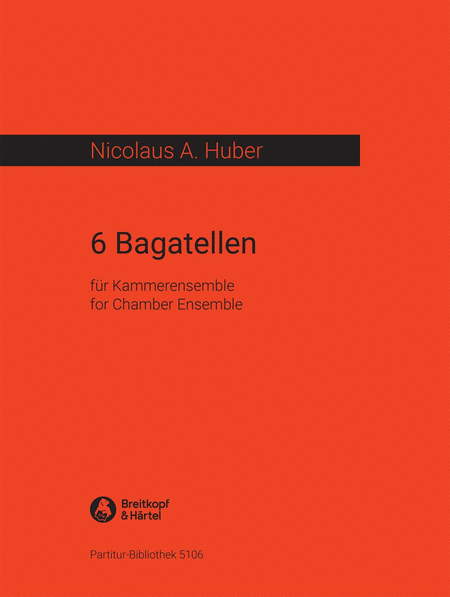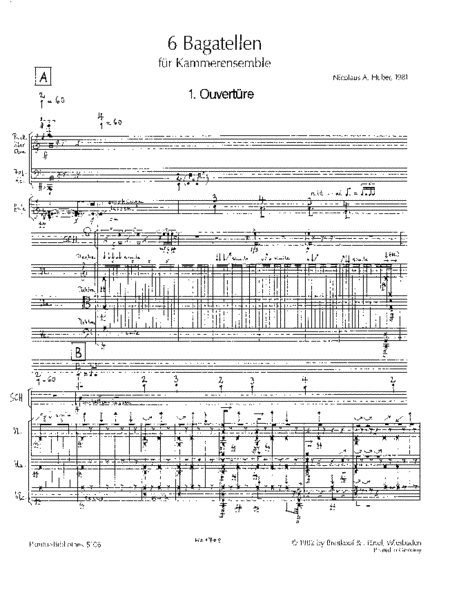6 Bagatelles
study score
Details
Description
SKU: BR.PB-5106-07
Study score. Composed by Nicolaus A. Huber. Stapled. Partitur-Bibliothek (Score Library).World premiere: Cologne, October 2, 1982
Music post-1945; New music (post-2000). Study Score. Composed 1981. 28 pages. Duration 22'. Breitkopf and Haertel #PB 5106-07. Published by Breitkopf and Haertel (BR.PB-5106-07).ISBN 9790004208564. 9 x 12 inches.
The 6 Bagatelles for Chamber Ensemble and Tape is dedicated to Dieter Schnebel. In particular, his speaking and thinking atmosphere in an interview with H. K. Metzger and R. Riehm (Neue Musik, No. 1 Dieter Schnebel, Cultural Forum Bonn Center) opened me to the freedom of thought necessary to write that which I wanted very much to write for a long time, listening only to myself. The title Bagatelles goes accordingly back to Beethoven and not to those of Webern (which of course were produced in a situation of radical language purification). No. 2 Mit Susse und Herbheit (dolce e secco). It is not very difficult to link this to op. 111, II. I have changed the very interesting and loud composition to one of my own which modulates to a political genre atmosphere. The thinking technique of the Beethoven Bagatelles op. 119, 10, which is only one line long and consists of only o n e striking musical thought, can be found again in No. 1 Ouverture (the entire piece is an extended overture rhythm model), in the mentioned No. 2 and No. 3: Traum-Mechaniks Wirren. The model of the first measure (b-b flat-a-g sharp) originates from my Traum-Mechanik. The additional word Wirren on the one hand refers to Schumann's Traumes Wirren (from Phantasiestucke, Nr. 7) in which a transposed version of my model (e flat-d-d flat-c) appears (measures 5-7) and on the other to the treatment technique. Treated as an ostinato in Traum-Mechanik, the model receives here constant and surprising changes in tone color, rhythm, dynamic, intervals (extensions and compressions of fourth tones), range (very slow, very high) and melody (at the end, the four chromatic tones are the same tones). The entire piece is based on unison. At the same time, another reference to Beethoven's Bagatelles expresses itself here through reminiscences of other (great) works (e. g. 9th Symphony). In No. 5, a hardedged Adagio, two different musical ideas, instead of one, are placed in block form next to each other. The title gives an analogy to visual art: the first part is a chain of 12 simple, solo tone block events, so to speak, joined together at right angles. No. 4 Tango and No. 6 Romanze belong to the genres which have a tradition in political art. In Tango a completely contrary interpretation of the Goethe poem uber allen Wipfeln ist Ruh (above all treetops is peace) also appears. Peace is not the personal, consoling and eternal peace of death (see Schubert's lied), but rather an awful cemetery peace which threatens us. Die Voglein (the little birds) are rogues which should at last keep silent. The question mark after Balde ruhest du auch? (soon you will have peace), which I added, should express the necessary campaign for a peaceful, creative life. The Romanze too goes back to a political form, the old Spanish romance, which extols the popular hero and which has not yet become to be the love romance. The structure of the music owes its origin to the literary assonance rhyme technique of the old romance. The heroes of our time are those who apply all of their abilities to the cause of peace. Is not the statement applicable here which the publisher Peters wrote to Beethoven when he offered them the Bagatelles op. 119 for publication: Your pieces are not worth the price and you should consider it below your dignity to spend your time on such trifling things which can be produced by anyone?(Nicolaus A. Huber)LP:Ensemble Modern, cond. Peter EotvosLP Harmonia Mundi HM 713 DBibliography:Birkenkotter, Jorg: Keine Kleinigkeiten: ,,Bagatellen, ,,Shrugs, ,,Statement ... Kurze Stucke im Werk Nicolaus A. Hubers, in: Nicolaus A. Huber, hrsg. von Ulrich Tadday (= Musik-Konzepte. Neue Folge 168/169), Munchen: edition text + kritik 2015, pp. 153-175.Heister, Hanns-Werner: Konspiration und Agitation. Ein Versuch uber die Sechs Bagatellen fur Kammerensemble von Nicolaus A. Huber, in: Melos 46 (1984), Heft 2, pp. 37-83.Huber, Nicolaus A.: THIRTY ARE BETTER THAN ONE (A. Warhol), in: Neue Musik und andere Kunste, hrsg. von Jorn Peter Hiekel (= Veroffentlichungen des Instituts fur Neue Musik und Musikerziehung Darmstadt, Band 50), Mainz u.a.: Schott 2010, pp. 220-235.Mainka, Jorg: Sprachspiele. Uber musikalische Dramaturgie, in: MusikTexte 128, Februar 2011, pp. 42-48.Spahlinger, Mathias: das starre - erzittert. zu nicolaus a. hubers bagatellen, in: MusikTexte 2 (1983), pp. 15-18.


 Share
Share